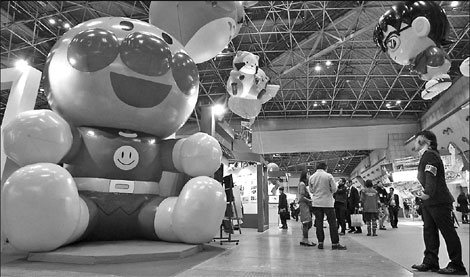Battle for control gets animated
|
Inflated animation characters are seen at the Tokyo International Anime Fair. Yuriko Nakao / Reuters |
China makes inroads into sector long dominated by Japanese firms
TOKYO - Yoko Komazawa had been at the Tokyo International Anime Fair for nearly six hours when she fell in love with a brown-and-white stuffed panda - a character in one of the fair's featured cartoons.
"It's so adorable and interesting," she said, staring into its eyes. "I want it."
Unfortunately, the panda wasn't for sale and Komazawa had to settle for a photo. But she walked away from the small booth impressed by the panda's creators - from China.
"Japan is certainly an amazing anime country," said the 30-something anime fan and collector of all things cute and cuddly. "China has some intriguing characters though. They're different, and that definitely catches my attention."
Komazawa's enthusiasm for something new is a small victory for China's fledgling animation industry, and could well represent a widening crack in Japan's global anime dominance. Japan may be the birthplace of anime, but China is gunning for its future as it mounts an aggressive effort to expand the country's creative prowess and reputation.
In November, the government's cultural arm established the China Animation Comic Group Co to foster a "great leap forward" in animation production, technology and marketing. Part of the plan includes building a "China Animation Game City" in Beijing that would be a national hub.
With government subsidies, Chinese animation companies tripled their presence at this year's Tokyo anime fair even as the overall number of exhibitors declined. The four-day event through Sunday, one of the world's biggest anime-related trade shows and festivals, featured a "China-Japan Anime Summit" along with multiple China-themed lectures.
"China is a big market, and everybody is trying to get in," said Jimmy Tse, chief executive of Top Art Investment Ltd, which makes the panda Komazawa craved. "And the Chinese people, they are starting to think, 'How come I'm manufacturing for someone else?' Why are we not creating anything ourselves?"
China's growing ambitions coincide with an ominous industrywide slump in Japan.
After peaking in 2006, the number of anime minutes made for television fell 20 percent to 108,342 in 2009, according to the Association of Japanese Animations. A survey of the group's members shows that overseas anime revenue fell 21 percent between 2006 and 2009.
Matt Alt, a Tokyo-based observer of Japanese pop culture, blames the industry itself for losing its edge. The world's hunger for anime accelerated around 2000, with Hollywood incorporating anime scenes into films.
The Japanese anime industry is beginning to realize that it cannot ignore China - as an emerging rival or a potentially lucrative new market. For both countries, cooperating appears to be the best option for now.
One of the most successful joint projects so far is the Romance of Three Kingdoms, a historical animated series currently airing across China. The program, produced by Japan's Takara Tomy and a subsidiary of China Central Television, will begin airing soon in Japan and elsewhere in Asia.
Associated Press
(China Daily 03/30/2010 page14)















